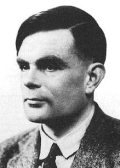History in a nutshell
 Fig. 1: Alan Turing |
Historical outlines:
- 1943: First AI work: Warren
McCulloch and Walter Pitt design a
neural network
 .
. - 1956: John McCarthy gathers the main scholars of the time in Dartmouth (among them Marvin Minsky, Allen Newell, Claude Shannon and Herbert Simon) for a seminary, where he proposes the name artificial intelligence.
- 1958: McCarthy produces the
Lisp
 ,
a high level programming language dedicated especially to AI.
,
a high level programming language dedicated especially to AI. - 1970-1980: Important developments in
research on neural networks. At the same time the first difficulties also
arise; one serious problem is the combinatory burst, the sudden increase of calculation time when the number of variables
increases in a problem.
The first expert systems are designed with applications
for medical diagnostics, and lead to the first attempts to understand natural language.
are designed with applications
for medical diagnostics, and lead to the first attempts to understand natural language.
- 1973:
Recent results on the resolution method (by J.A. Robinson) give birth to
Prolog
 ,
, - 1980-today: AI comes out of the science laboratories and finds significant practical applications. At the same time, as a consequence, industrial companies especially in America and Japan start to market programs focusing on expert systems, on configuration recognition and so on, building microcircuits and whole computers specialised in AI applications.